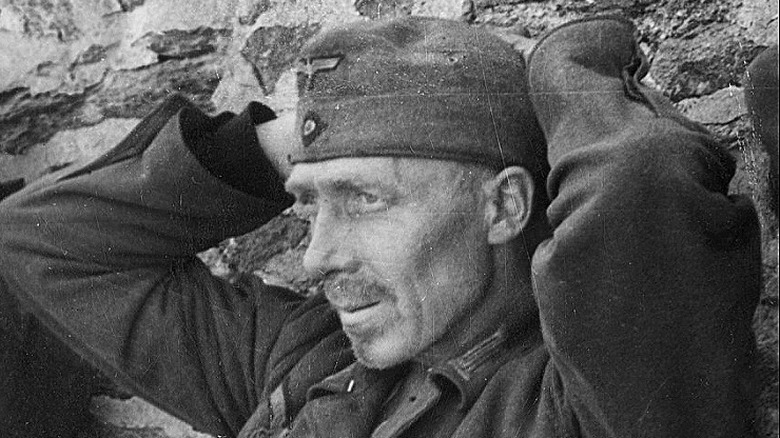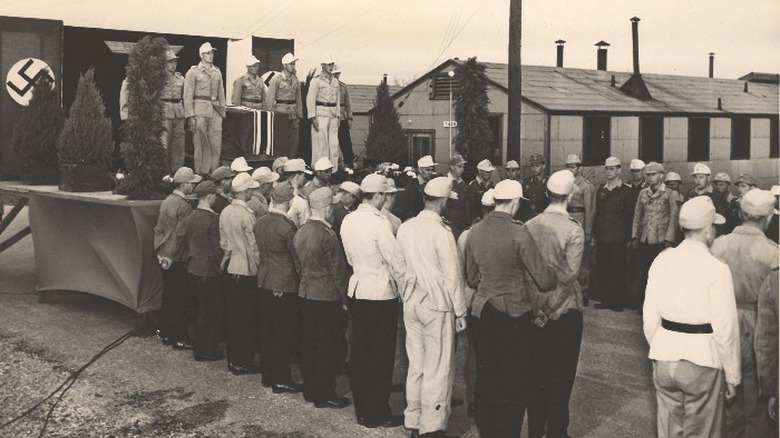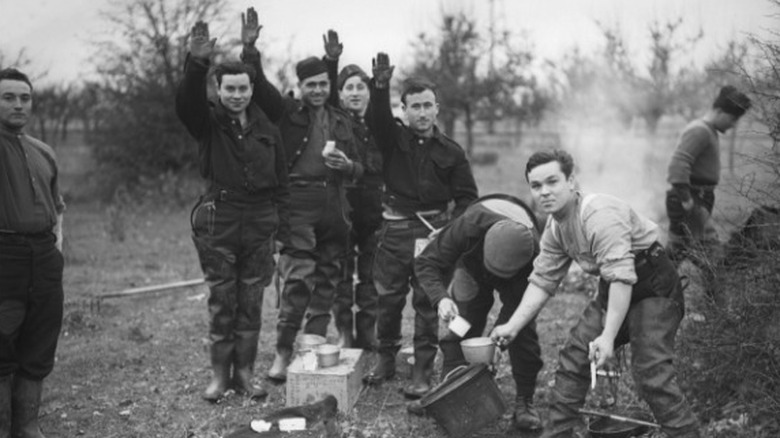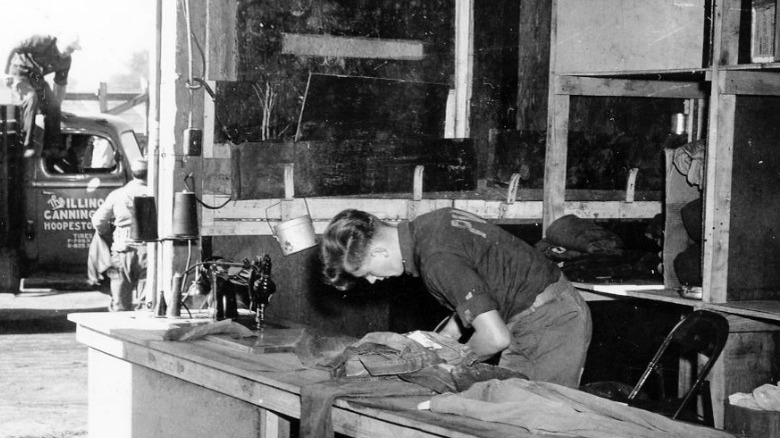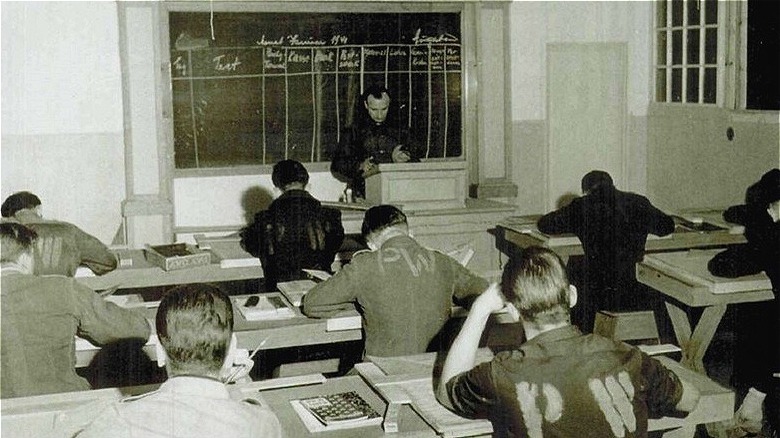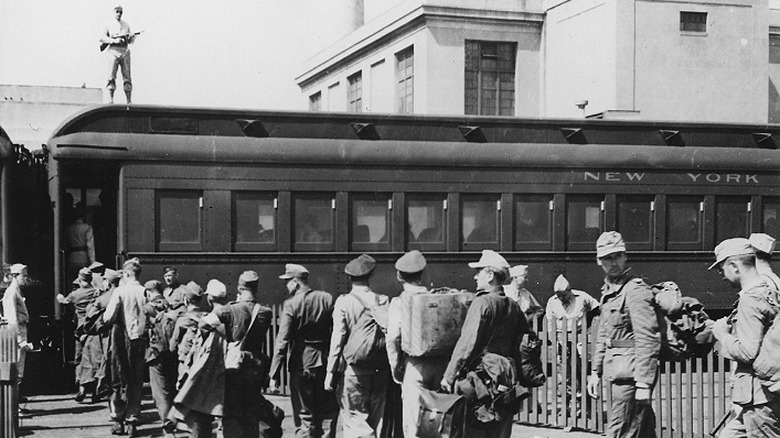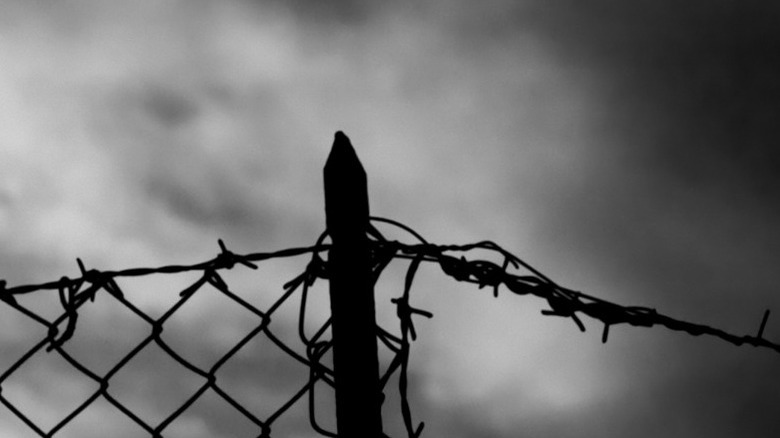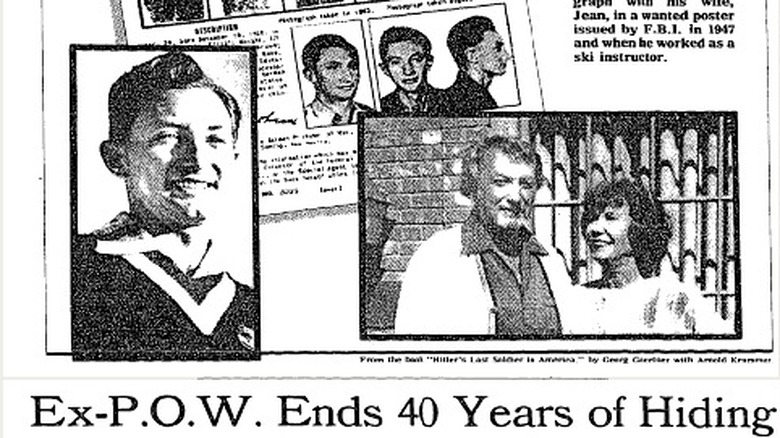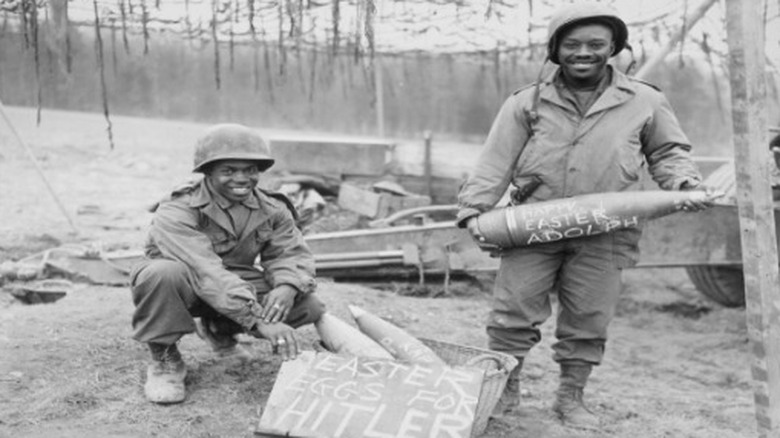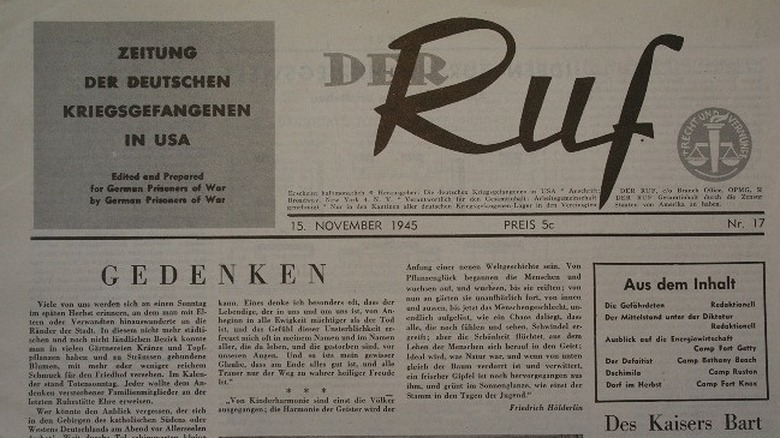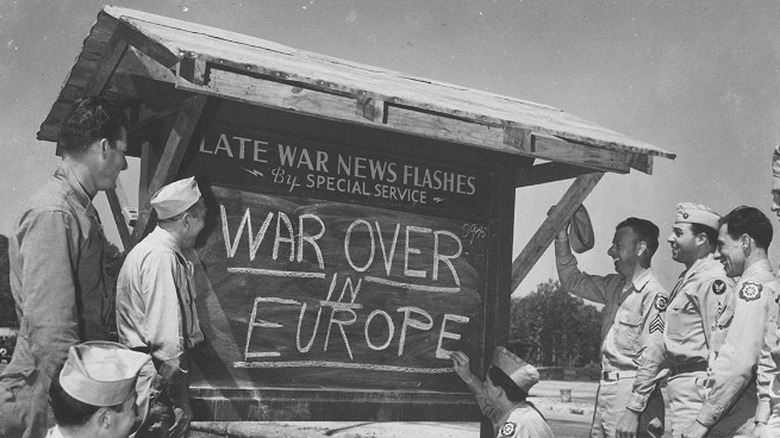The Untold Truth Of America's WWII German POW Camps
Justifiably, much has been written about America's World War II Japanese internment camps and the systemic racism that spawned them. Less well known are the prisoner of war camps that sprang up in rural communities across the country to house combatants from Europe and Japan. Although the POW camps opened and closed with little fanfare, their unique design and deployment — in painful contrast to the Japanese internment camps — have earned them their own notable place in the war's history.
According to Smithsonian Magazine, in 1942, as Great Britain was running out of places to hold Axis prisoners, the U.S. began work on creating its own network of POW camps. It was an enormous and complex task, but over the next three years, the War Department succeeded in housing more than 400,000 POWs in some 500 camps.
As noted in Humanities Texas, the first big batch of POWs arrived in the spring of 1943 following the surrender of Germany's Afrika Korps. Between then and mid-1944, an average of 20,000 POWs arrived each month, then after the Normandy invasion, the average rose to 30,000. By the war's end, the average reached 60,000 POWs per month. The majority of the camps were located in the Midwest, South, and Southwest, and the biggest contingency of POWs — 372,000 — were German. And it was the Germans, Nazi and non-Nazi, who defined camp life more than any other group of captives.
The POW camps adhered to the Geneva Conventions
According to Society for Military History, because of its scant experience dealing with POWs, the U.S. chose to follow the edicts of the untried 1929 Geneva Convention. The foundational objectives of the Convention were to "prevent indignities against enemy soldiers" and to ensure that, through the humanitarian treatment of enemy soldiers, American POWs would be equally protected when held by enemy nations. Unfortunately, while the U.S. generally honored the Convention, neither Japan, which never signed the agreement, nor Germany, which chose to ignore it, did.
The far-reaching 1929 Convention covered such things as camp location, punishments for escapes, and restrictions regarding POW labor. As noted by the Library of Congress, among the many protections and guarantees provided to POWs were adequate food, housing, and medical care, "protection from violence, intimidation, insults, and public curiosity," prohibition against medical experimentation, and reciprocal military rights and status.
According to Society for Military History, to create rights and status equal to the U.S. military, German officers above the rank of captain were assigned their own POW orderlies and generals were housed in private huts. Per articles of the Convention, American soldiers were compelled to salute higher ranking POWs, and the infamous Nazi salute was permitted. The Convention allowed the display of swastikas, and some POWs were buried in local military cemeteries with Nazi flags and with swastikas engraved on their headstones.
Hardcore Nazi POWs were a problem
Undoubtedly the biggest source of conflict in the POW camps were the ardent Nazis. According to the Society for Military History, because the Geneva Convention limited how differently one POW could be treated from another, camp authorities initially made "no distinction between ideologically hardened prisoners and those who are 're-educated.'" Consequently, fanatical Nazis were thrown in with anti-Nazis.
In addition, Article 43 of the Convention required the appointment of POW administrators, and often, Nazi officers would assume this role, becoming in effect, camp commandants. They ruled with an iron fist, ordering work stoppages and holding kangaroo courts. As noted in New Georgia Encyclopedia, the hard-liners doled out harsh discipline and attacked fellow prisoners for their lack of patriotism, among other offenses. As documented in by the Society for Military History, between September 1943 and April 1944, in camps across the country, "6 murders, 2 forced suicides, 43 'voluntary' suicides, a general camp riot, and hundreds of localized acts of violence occurred." During one kangaroo court in Georgia, two pro-Nazi POWs charged an anti-Nazi POW with being an informant and liking American jazz. For his "crimes," they strangled him to death.
Although the Georgia camp killers were convicted in 1945, Nazi perpetrators, protected by the Convention, usually received minimal or no punishment. Some were transferred to a special camp for Nazi incorrigibles in Oklahoma. Eventually, in the wake of the Nazis' six-month reign of terror, the War Department acknowledged the problem and began to enact reforms.
German POWs were put to work
As all work done by POWs was forced labor, work regulations, including details like job locations and hours, hazards, and pay rates, were a major concern of the 1929 Geneva Convention. As noted in Humanities Texas, POWs were put to work right from the start, although their assignments were limited due to fears of escape, sabotage, and overseas exploitation. When labor shortages due to enlistment hit the American economy, however, the War Department rethought its strategy and greatly expanded POW labor.
While still adhering to the Convention, the POW camps supplied local industries and businesses with laborers. In Texas, for example, POWs picked cotton, harvested fruit, and chopped sugar. In Kansas, according to Smithsonian Magazine, they stacked hay and did masonry. In New England, they harvested peas, cabbage, and apples. They worked as lumberjacks, mechanics, sign painters, tailors, and in hundreds of other positions, according to History of Prisoner of War Utilization by the United States Army 1776 to 1945.
All enlisted men were required to work, and they were paid 80 cents a day, the same rate American privates received. To keep them from accumulating enough cash to bankroll an escape, prisoners were paid in canteen coupons. Over time, the POWs not only proved themselves capable workers — troublemaking Nazis aside — they also earned the trust and admiration of many of their private employers. As a result, their supervision relaxed, sometimes to the point of being unguarded and unwatched.
German POWs got unexpected perks
As described in The Washington Post, the War Department, believing that a happy POW was a pliant POW, went above and beyond when it came to POW food, education, and entertainment. Not only did POWs dine well, they took college courses, set up libraries, and formed orchestras and soccer leagues. Leisure activities included Ping-Pong, chess, and card games. Some camps had printing presses that churned out newsletters penned by POWs. Hollywood movies and cartoons were screened.
POWs mounted theatrical productions and played concerts. POW Fritz Ensslin noted in a letter (via The Fallen Foe) that at his Missouri camp a "cabaret theater and even a dance group consisting of 12 'girls' trained by a ballet master" gave performances that were regularly attended by American officers. Also offered was circus and acrobatic instruction, including trampoline jumping, taught by professional circus performers. Educational programs were varied. Some classes were taught by the POWs themselves, others were conducted as correspondence courses. The level of instruction was so high that some German universities offered full credit to returning POWs.
Although some in Congress decried this apparent "coddling" of the POWs, the War Department, as noted by HistoryNet, remained confident that news of the benefits enjoyed by the POWs would reach Germans still fighting overseas and encourage their surrender. Indeed, in correspondence, one POW described his camp as a "goldener Kafig," or golden cage, while another wrote home to say imprisonment was like a "rest-cure."
German POWs were controversial in local communities
When the first wave of POWs from Germany's elite Afrika Korps arrived in Mexia, Texas, the townspeople were dumbstruck, according to Humanities Texas. They stared "open-mouthed" as the POWs "jumped down from railroad cars and marched in orderly rows to the camp four miles west of town." Similar scenes played out across rural America, but over time, as noted in The Washington Post, many of these small communities adjusted to the POW presence. Some even "started to enjoy the novelty."
Many locals recognized the vital role the POWs played in their local businesses, and quite a few befriended their captive employees, continuing relationships even after the war, as noted in HistoryNet. In Kansas, for example, some farmers invited their POW workers for meals and allowed them to go hunting or pony riding unattended. However, not all towns and townspeople were happy hosts. In Texas, according to Humanities Texas, some residents feared having Nazis nearby and, worried about escapes, locked their doors and cautioned their daughters. Other citizens wrote angry letters to the editor and staged protests.
According to American Reeducation of German POWs, 1943-1946, as the war dragged on and U.S. casualties mounted, stories about cushy POW camp life and vicious crimes committed by Nazis prisoners enraged many Americans. Aware that POWs were actually eating better than many civilians, the War Department, sensitive to public perception, cut back severely on the POWs' rations.
Sometimes POWs escaped
Although the total number of escape attempts from U.S. camps was proportionately low, according to Humanities Texas, some POWs did try. The 1929 Geneva Convention, recognizing that it is the duty of prisoners to attempt escape, contains numerous regulations limiting the severity of punishments for escapees. Consequently, the POWs had little concern about getting caught. Some escaped out of homesickness, some out of patriotism, some out of fear of being returned to their altered homeland.
As noted by Humanities Texas, methods of escape were as varied as reasons for trying and were occasionally quite inventive. POWs built secret tunnels, slipped away from inattentive guards, constructed dummies of themselves, and impersonated U.S. officers, among other tricks. Once outside, they hopped trains or stole cars. Many simply took off on foot.
The most elaborate escape attempt occurred in 1944, at one of the more spartan camps in Texas. Using a secret 60-foot tunnel equipped with lighting and air bellows, 12 German officers slipped away from their barracks and, armed with tissue-paper maps, went separately toward Mexico. Each man had food and a change of clothing. Despite their careful planning, 10 were captured within days, far from the border. Two were caught by an El Paso railroad detective just before reaching the border.
The majority of escapees were captured quickly and without incident. Back at camp, fellow POWs hailed them as heroes. A few escapees eluded capture for many years. Only one escaped entirely.
The POW that got away
As chronicled by AP, on a September night in 1945, POW Georg Gaertner escaped from New Mexico's Camp Deming by slipping under a fence and hopping a train bound for San Pedro. According to the Coloradoan, Gaertner had decided to escape because he knew that upon his release, he would be repatriated to eastern Germany, where his family lived. Eastern Germany had fallen under Russian control, and as a former Nazi, Gaertner feared he would be sent to a gulag.
From San Pedro, Gaertner, who spoke fluent English, traveled north undetected, taking a series of odd jobs on the West Coast, including fruit picker, logger, and ski instructor. In Oakland, he landed a steady salesman job, and in 1964, he met his wife Jean. Now called Dennis Whiles, Gaertner told Jean he had been raised in an orphanage, thus eliminating any questions about his family.
Gaertner stayed under the radar for years, and eventually the authorities stopped looking for him. Jean remained unaware of his secret until impending retirement required she obtain his birth certificate. Gaertner finally confessed, and Jean, determined he should turn himself in, began researching the POW camps. Her research led her to Arnold Krammer, who ended up writing a tell-all book with Gaertner. In 1985, Gaertner surrendered to the INS and, as a publicity stunt, to Bryant Gumbel on "Today." Of the 2,222 POWs who attempted escape, Gaertner was the only one to have eluded capture.
German POWs were treated better than Black Americans
As noted by Time, until 1948, the U.S. military was, like much of America, a segregated institution. Black soldiers experienced institutionalized discrimination both at home and overseas, and their prejudicial treatment occurred at the hands of not only white Americans but white POWs as well. In Southern POW camps, some facilities were segregated by race, and Black servicemen were given the worst jobs. Blacks in the military expressed outrage that, after risking their lives fighting Nazis, they were considered beneath their white enemies back home. Incidents like Black soldiers being forced to dispose of the POWs' human waste and POWs refusing to follow instructions from Black work supervisors infuriated Black servicemen.
In "Icons of Insult: German and Italian Prisoners of War in African American Letters During World War II," author Matthias Reiss recounts numerous instances of racist encounters involving white Americans and POWs. In one incident, Black servicemen were barred from entering a restaurant at a Texas train station while POWs were invited inside to dine with their white captors. Another episode involved entertainer Lena Horne, who, while performing at an Arkansas camp, became enraged when she saw that Black servicemen had been seated behind the POWs.
Not only was racism detrimental to Black servicemen's morale, it also became a Nazi propaganda talking point. As noted in American Reeducation of German POWs, 1943-1946, in discussions with their guards, prisoners would sometimes use America's discriminatory practices as a "what about" counter argument.
POWs were secretly reducated
According to American Reeducation of German POWs, 1943-1946, in 1944, as Allied victory appeared imminent, U.S. officials began to plan for a post-war Germany. Out of the ruins of fascist defeat, the U.S. and its allies hoped to plant the seeds of democracy. At the same time, stories about Nazi violence and influence in the POW camps were beginning to circulate. When a group of female columnists informed Eleanor Roosevelt about the situation, she vowed to investigate and take action.
The result of the First Lady's initiative was the Prisoner of War Special Projects Division, led by Lt. Col. Edward Davison out of Camp Kearney in Rhode Island. To ensure its success in the camps, the project was kept top secret. A handpicked group of intellectual American officers joined forces with anti-Nazi POWs, and the democracy-promoting strategies of The Factory, as it became known, were devised.
The Factory's first step in the POW camps was the distribution of books banned by Hitler. Complementing that were screenings of carefully selected movies, including horrifying footage showing the liberation of Nazi concentration camps. The Factory also created Der Ruf, a German-language newsletter, "written by German POWs for German POWs." To disguise its purpose, The Factory POW staff interspersed pro-democracy tracts with fiction and other entertaining fare. Although Nazi POWs denounced Der Ruf as Jewish propaganda, according to the New England Historical Society, most POWs loved reading it, and its effectiveness at changing hearts and minds was indisputable.
Some POWs became US citizens
After Germany's surrender in May 1945, the process of POW release and repatriation began. According to Humanities Texas, many in America, especially farmers, were loathed to see them go. Labor unions, however, regarded them as competition for returning U.S. forces and demanded their expulsion. President Harry Truman ordered them sent back to Europe "to whichever country wanted them."
As a result of Truman's order, many POWs ended up in the "unfriendly hands" of France and England. According to the Society for Military History, the last batch of them — 1,500 German prisoners — sailed from New Jersey on July 26, 1946. Although America's treatment of POWs earned high marks from most German prisoners, its repatriation policy was widely criticized. In his written account (via The Fallen Foe), POW Fritz Ensslin, for example, claimed that many transferred POWs died in France performing "forced labor."
As noted in Returning to America: German Prisoners of War and American Experience, of the more than half million Germans who immigrated to America between 1947 and 1960, several thousand were former POWs. Having experienced the "American way of life," some POWs sought U.S. sponsors or worked for U.S. occupational forces in Germany in order to return to the U.S. POW John Schroer recalls that he made his decision to immigrate upon seeing the Statue of Library as he departed New York. "It was a beautiful day, all looked so peaceful."
